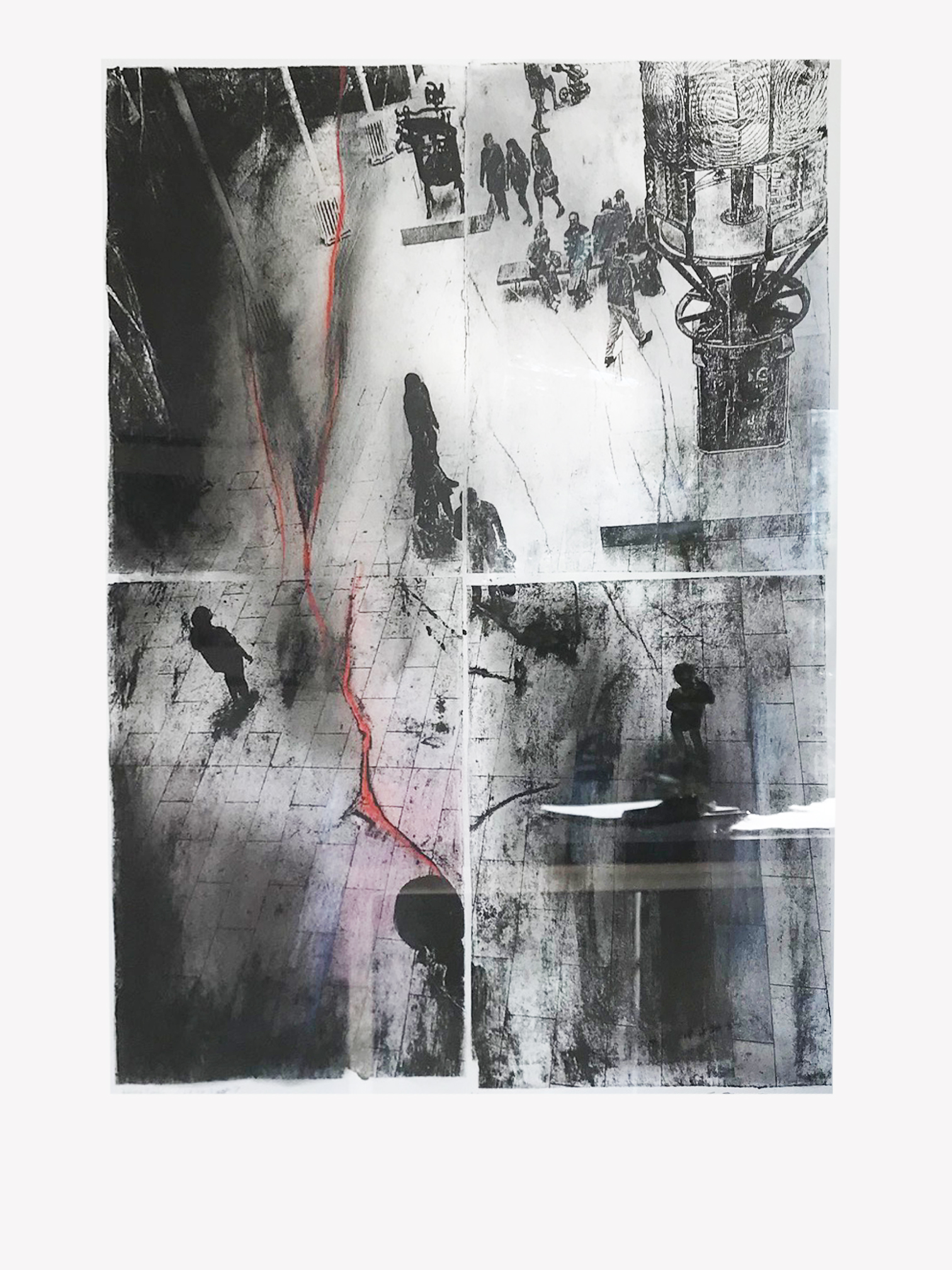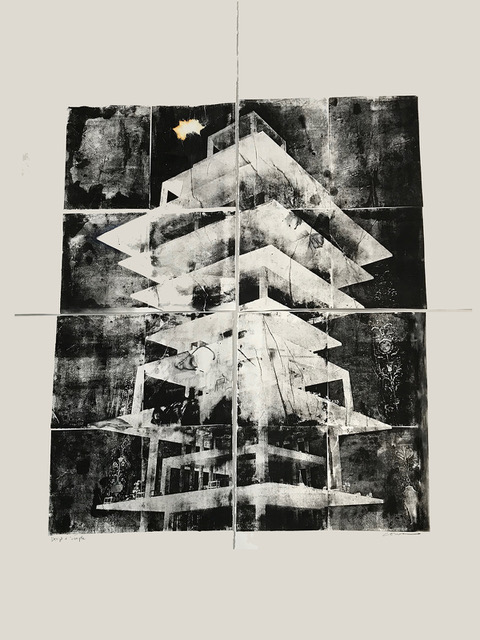A Conversation with October Featured Artists Lisa Goesling and Julie Cowan
What are your earliest memories of art? How did you become an artist yourself?
LG: One of my earliest art memories is of selling my homemade coloring books to kids in the neighborhood. My feet didn't even touch the ground while I sat behind my little snack table filled with hand drawn books. Kids would snatch them up and then I'd run back inside to make more.
Creativity was encouraged growing up which was a good thing because I didn't much care about academics. All I really wanted to do was to create. I got the chance to do a lot of that at age twelve when I began taking classes at School of the Art Institute (SAIC). Riding the Howard El to the city was an adventure in itself, and then I would enter this world of endless possibilities! I began to form my foundation as a visual artist through drawing, painting and sculpture. We were allowed to wander the Art Institute after class and I always found myself immersed in the art from Ancient Asia. Using nature as their muse, they layered details and textures creating a lyrical sense of movement. It is still one of my favorite destinations in the museum.
JC: I was always an observant person and I could draw representationally. So I received encouragement from others from a young age to pursue arts. When I was about 10 or 12, I was influenced by a friend of our family, a lovely woman painter. She shared materials, and described her work. She demonstrated that being an artist was possible. By the time I got to high school and then college, I was making art and then trained as a designer too.
What has been your evolution as an artist?
LG: After finishing high school and my studies at SAIC, I decided to major in Graphic Design so that I could continue creating my art but have the assurance of a steady income from design.
My first job out of school was Public Relations Director for the Covenant Club of Illinois which was located at 10 N. Dearborn, in Chicago. Mayor Richard J. Daley frequented the club and I was always rushing off to photograph him gathering with the movers and shakers of the business world, then I’d write about it in the Covenant Club News.
Next I produced/designed textbooks, art and travel books for Rand McNally & Co., and then took a job as an art director for a mid-sized ad agency in Chicago. From there I opened my own design studio and continued to work full time until slowing down to raise my children. I always created art throughout every junction.
I discovered my favorite medium, Scratchbords (by Ampersand Art Supply), while undergoing a cancer diagnosis in 2006, they were portable and all I needed was a simple tool. Getting lost in the details transported me to a better place. I am still drawn to the sheer wonder of dragging my knife into the layers of ink and clay, witnessing the board slowly evolve into a sophisticated work of art. I continue to enjoy the spontaneity of jumping right in and seeing where it leads me. Sometimes I create detailed elements from nature; sometimes I use them as inspiration in my abstracts.
JC: Drawing was my first medium. I would draw and sketch all the time. I did graphic design in college and then professionally. It took some time for me to decide that it was acceptable to incorporate digital imagery with my art, that it wasn’t cheating. Now I see all of the skills, whether hand drawing, photography, printmaking, or digital imagery, work together as tools in confluence to build the works.
My first experience with printmaking was in Prague, Czechoslovakia, in the early 1990s, where I worked with master printer, Tomas Svoboda. It was a life-changing experience as I drew on a litho stone and he printed the image with perfection. I drew in his studio with other artists from around Europe, each of us working on our own projects in a shared space. We shared an artistic camaraderie and it was amazing. I appreciate the feeling of connection and inspiration from other artists. I have been seeking this kind of artistic community and connection for a long time. It is difficult to find when one works alone in a home studio. I decided to start printmaking again about 10 years ago, when I had access to a press and print shop. My work has changed from pure abstract monoprinting to these paper lithographs. The work has also gotten bigger.
Are there any artists who have inspired and influenced you in your work? If so, who are they?
LG: As I mentioned earlier, I absolutely love the detailed art from ancient Asia. In addition, I have always been drawn to the delicate renderings by Albrecht Durer. I am in awe of his incredible ability to capture details, particularly in his sketches.
JC: My work has been influenced by Hiroshi Sugimoto, a photographer who showed large-scale photos of architecture at the MCA in 1995. The images are imprinted in my head - they were tall skyscrapers in black and white enveloped in fog and mist and they continue to have an impact on my work.
Can you describe your process for creating a work of art? Are there any colors that you particularly like using?
LG: Scratchbords by Ampersand are hard boards covered in a layer of Kaolin Clay (used to make Porcelain) and then India Ink. When I etch away at the ink with an X-ACTO knife, the image appears in the clay. If I like, I can add colored inks or paints at the end of the process. It is a slow, precise path, layering line over line, and color over color. I always tell people that it takes a lot of artistic courage to approach a medium like this since I do not sketch or erase, I just jump right in! Unlike traditional etchings where prints are made, each one of these creations are an original piece of art.
JC: I have two interests: portraiture and architecture.
With portraiture, I begin by taking close-up photographic imagery of people I know and strangers I meet. I select an image and then digitally alter the photos to create greater contrasts and stronger line. The photographs, as well as the printmaking technique, reveal imperfection. The delicate nature of the paper printing plates helps to create unique effects that reflect and capture the individual, when the paper tears, rips and wrinkles. These effects of uncertainty integrate into the faces and expressions creating unique monoprints.
In work with an architecture theme, I investigate the idea of place and how spaces make us feel either embraced or alienated. Using interior and exterior photos, I often layer various photographic elements to create new spaces or I try to capture a part of a space to give a perspective that is surprising.
Usually I work on fine printmaking paper. I have recently started to print on wool felt, creating a palpable, textural, and somewhat obscured image. I have also explored working on multiple sheets of paper for a single image to create large images. Big is very interesting to me.
Generally, I like to print with black ink and then hand color. I do not have favorite colors but I often think that the right color does not exist.
How did you meet each other and what was the process of deciding to do a joint show here at Vivid? How do your works relate to one another?
LG: Julie and I actually met at a ‘Meet The Artists’ event at Vivid. It was a case of mutual appreciation for each other and our art. Soon afterwards, Julie showed up at my opening at Dittmar Art Gallery at Northwestern and we talked about the similarities in our art. I especially love the level of depth she creates through contrast, shapes and textures, something that I concentrate on with my art as well.
JC: Lisa and I met each other through Vivid. We respected each other’s work and thought that our work was complementary and would show together well. I love the composition and fine hand of Lisa’s art as well as the intensity of the blackness, the composition of line. In contrast, my work is often blurry and vague, without specific detail and is derived from photographs, without specific intention. This show is titled “Mystified.” When we talked about it, we thought that our work approaches the obscured or the mysterious in the subjects we choose and the results of our artistic practices.
We liked each other too.
Lisa, most of your work is based on nature. Is there a reason why you are particularly interested in creating such work?
LG: My years as a graphic designer have sensitized me to find design in everything, and there is no better example than nature. While I often introduce abstract images into my art, the foundation is always nature’s intricate patterns, shapes, textures and colors. My art is heavily influenced by Eco-Psychology, the study of emotional connections between humans and the natural world. I strive to produce the same sensations in my art that we experience while connecting with nature …wonder, harmony and timelessness.
Just like in nature, my art is filled with layers upon layers of details, creating a level of intimacy for the viewer. I have had many buyers tell me that they see something new every time they look at their art.
Julie, most of your work is based on architecture and portraits. Is there a reason why you are particularly interested in these types of work?
JC: Regarding architectural subject matter, I wanted to design buildings since I was fairly young, even to become an architect. I was no good at that but I remained interested in the built environment and how we interact with space. I take many photos, both interior and exterior, with hope of discovering spaces that touch us, inspire us, connect us.
In terms of portraiture, I like to draw out the emotion in people’s faces from photos that I take of friends, family, and strangers. The first portrait I printed was of my daughter. I was so surprised by the image that emerged as I recognized her and was also challenged by some degree of unfamiliarity. I thought that was so exciting and it led me to take more photos to see what i could uncover.
Where do you see your work going from here?
LG: My art is always evolving, I hope that every artist can say the same. I like to push the boundaries of what can be done with Scratchboards by adding a range of different blacks allowing for multiple levels of interest. Generating a sense of movement through line is important to me. I began to explore new ways of incorporating that into my art, leading to the creation of ‘Across The Board’. My concept of combining twelve 2 dimensional ‘etchings’ into a 3 dimensional accordion like sculpture has been realized.
I hope to continue my trajectory of increasing interest in my art for many years to come.
JC: I want to create more large scale pieces that will hang in public places. I am very interested in public participation in art.







